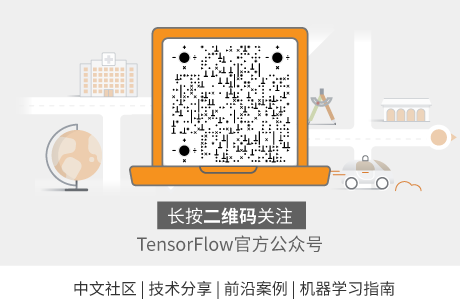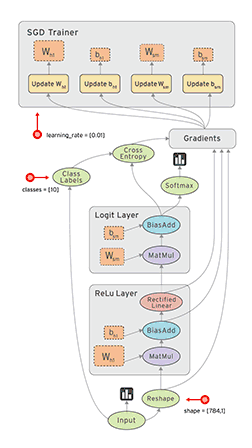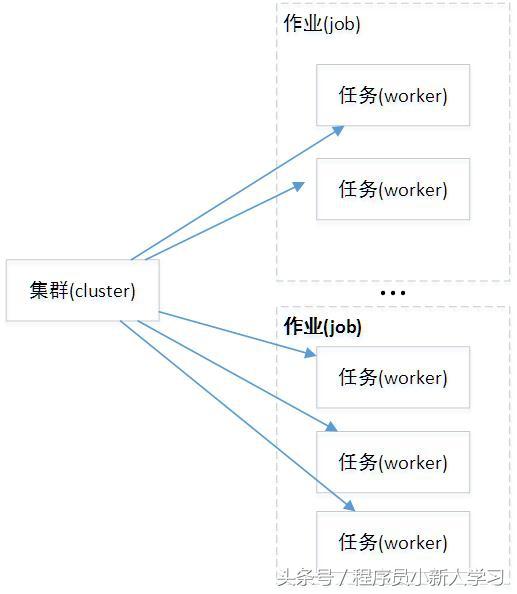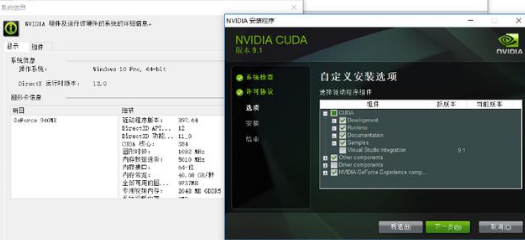大家好,今天我们来给讲讲关于 TensorFlow 在 GPU 中的使用规则。
支持的设备
在一套标准系统中通常有多台计算设备。TensorFlow 支持CPU和GPU这两种设备。它们均用strings表示。例如:
如果 TensorFlow 指令中兼有 CPU 和 GPU 实现,当该指令分配到设备时,GPU 设备有优先权。例如,如果matmul同时存在 CPU 和 GPU 核函数,在同时有cpu:0和gpu:0设备的系统中,gpu:0会被选来运行matmul。
记录设备分配方式
要找出您的指令和张量被分配到哪个设备,请创建会话并将log_device_placement配置选项设为True。
# Creates a graph.
a = tf.constant([1.0, 2.0, 3.0, 4.0, 5.0, 6.0], shape=[2, 3],)
b = tf.constant([1.0, 2.0, 3.0, 4.0, 5.0, 6.0], shape=[3, 2],)
c = tf.matmul(a, b)
# Creates a session with log_device_placement set to True.
sess = tf.Session(config=tf.ConfigProto(log_device_placement=True))
# Runs the op.
print(sess.run(c))
您应该会看到以下输出内容:
Device mapping:
/job:localhost/replica:0/task:0/device:GPU:0 -> device: 0, name: Tesla K40c, pci bus
id: 0000:05:00.0
b: /job:localhost/replica:0/task:0/device:GPU:0
a: /job:localhost/replica:0/task:0/device:GPU:0
MatMul: /job:localhost/replica:0/task:0/device:GPU:0
[[ 22. 28.]
[ 49. 64.]]
手动分配设备
如果您希望特定指令在您选择的设备(而非系统自动为您选择的设备)上运行,您可以使用with tf.device创建设备上下文,这个上下文中的所有指令都将被分配在同一个设备上运行。
# Creates a graph.
with tf.device(‘/cpu:0’):
a = tf.constant([1.0, 2.0, 3.0, 4.0, 5.0, 6.0], shape=[2, 3],)
b = tf.constant([1.0, 2.0, 3.0, 4.0, 5.0, 6.0], shape=[3, 2],)
c = tf.matmul(a, b)
# Creates a session with log_device_placement set to True.
sess = tf.Session(config=tf.ConfigProto(log_device_placement=True))
# Runs the op.
print(sess.run(c))
您会看到现在a和b被分配到cpu:0。由于未明确指定运行MatMul指令的设备,因此 TensorFlow 运行时将根据指令和可用设备(此示例中的gpu:0)选择一个设备,并会根据要求自动复制设备间的张量。
Device mapping:
/job:localhost/replica:0/task:0/device:GPU:0 -> device: 0, name: Tesla K40c, pci bus
id: 0000:05:00.0
b: /job:localhost/replica:0/task:0/cpu:0
a: /job:localhost/replica:0/task:0/cpu:0
MatMul: /job:localhost/replica:0/task:0/device:GPU:0
[[ 22. 28.]
[ 49. 64.]]
允许增加 GPU 内存
默认情况下,TensorFlow 会映射进程可见的所有 GPU 的几乎所有 GPU 内存(取决于CUDA_VISIBLE_DEVICES)。通过减少内存碎片,可以更有效地使用设备上相对宝贵的 GPU 内存资源。
在某些情况下,最理想的是进程只分配可用内存的一个子集,或者仅根据进程需要增加内存使用量。TensorFlow 在 Session 上提供两个 Config 选项来进行控制。
第一个是allow_growth选项,它试图根据运行时的需要来分配 GPU 内存:它刚开始分配很少的内存,随着 Session 开始运行并需要更多 GPU 内存,我们会扩展 TensorFlow 进程所需的 GPU 内存区域。请注意,我们不会释放内存,因为这可能导致出现更严重的内存碎片情况。要开启此选项,请通过以下方式在 ConfigProto 中设置选项:
config = tf.ConfigProto()
config.gpu_options.allow_growth = True
session = tf.Session(config=config, …)
如要真正限制 TensorFlow 进程可使用的 GPU 内存量,这非常实用。
在多 GPU 系统中使用单一 GPU
如果您的系统中有多个 GPU,则默认情况下将选择 ID 最小的 GPU。如果您希望在其他 GPU 上运行,则需要显式指定偏好设置:
# Creates a graph.
with tf.device(‘/device:GPU:2’):
a = tf.constant([1.0, 2.0, 3.0, 4.0, 5.0, 6.0], shape=[2, 3],)
b = tf.constant([1.0, 2.0, 3.0, 4.0, 5.0, 6.0], shape=[3, 2],)
c = tf.matmul(a, b)
# Creates a session with log_device_placement set to True.
sess = tf.Session(config=tf.ConfigProto(log_device_placement=True))
# Runs the op.
print(sess.run(c))
如果您指定的设备不存在,您会看到InvalidArgumentError:
InvalidArgumentError: Invalid argument: Cannot assign a device to node ‘b’:
Could not satisfy explicit device specification ‘/device:GPU:2’
[[Node: b = Const[dtype=DT_FLOAT, value=Tensor values: 1 2 3…>, _device=”/device:GPU:2″]()]]
当指定设备不存在时,如果您希望 TensorFlow 自动选择现有的受支持设备来运行指令,则可以在创建会话时将配置选项中的allow_soft_placement设为True。
# Creates a graph.
with tf.device(‘/device:GPU:2’):
a = tf.constant([1.0, 2.0, 3.0, 4.0, 5.0, 6.0], shape=[2, 3],)
b = tf.constant([1.0, 2.0, 3.0, 4.0, 5.0, 6.0], shape=[3, 2],)
c = tf.matmul(a, b)
# Creates a session with allow_soft_placement and log_device_placement set
# to True.
sess = tf.Session(config=tf.ConfigProto(
allow_soft_placement=True, log_device_placement=True))
# Runs the op.
print(sess.run(c))
使用多个 GPU
如果您想要在多个 GPU 上运行 TensorFlow,则可以采用多塔式方式构建模型,其中每个塔都会分配给不同 GPU。例如:
# Creates a graph.
c = []
for d in [‘/device:GPU:2’, ‘/device:GPU:3’]:
with tf.device(d):
a = tf.constant([1.0, 2.0, 3.0, 4.0, 5.0, 6.0], shape=[2, 3])
b = tf.constant([1.0, 2.0, 3.0, 4.0, 5.0, 6.0], shape=[3, 2])
c.append(tf.matmul(a, b))
with tf.device(‘/cpu:0’):
sum = tf.add_n(c)
# Creates a session with log_device_placement set to True.
sess = tf.Session(config=tf.ConfigProto(log_device_placement=True))
# Runs the op.
print(sess.run(sum))
您会看到以下输出内容:
Device mapping:
/job:localhost/replica:0/task:0/device:GPU:0 -> device: 0, name: Tesla K20m, pci bus
id: 0000:02:00.0
/job:localhost/replica:0/task:0/device:GPU:1 -> device: 1, name: Tesla K20m, pci bus
id: 0000:03:00.0
/job:localhost/replica:0/task:0/device:GPU:2 -> device: 2, name: Tesla K20m, pci bus
id: 0000:83:00.0
/job:localhost/replica:0/task:0/device:GPU:3 -> device: 3, name: Tesla K20m, pci bus
id: 0000:84:00.0
Const_3: /job:localhost/replica:0/task:0/device:GPU:3
Const_2: /job:localhost/replica:0/task:0/device:GPU:3
MatMul_1: /job:localhost/replica:0/task:0/device:GPU:3
Const_1: /job:localhost/replica:0/task:0/device:GPU:2
Const: /job:localhost/replica:0/task:0/device:GPU:2
MatMul: /job:localhost/replica:0/task:0/device:GPU:2
AddN: /job:localhost/replica:0/task:0/cpu:0
[[ 44. 56.]
[ 98. 128.]]
cifar10 教程就是个很好的例子(),演示了如何使用多个 GPU 进行训练。

限 时 特 惠: 本站每日持续更新海量各大内部创业教程,一年会员只需98元,全站资源免费下载 点击查看详情
站 长 微 信: lzxmw777






